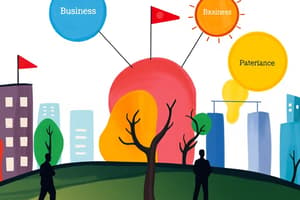Podcast
Questions and Answers
What does the degree of change in environmental uncertainty refer to?
What does the degree of change in environmental uncertainty refer to?
- The number of competitors in the industry
- The frequency of component changes in the organization’s environment (correct)
- The quality of human resources within the organization
- The knowledge an organization has about its environment
Which of the following is NOT considered a part of the general environment?
Which of the following is NOT considered a part of the general environment?
- Economic factors
- Competitors (correct)
- Socio-cultural factors
- Environmental factors
Which of these factors does NOT belong to the major forces in the general environment?
Which of these factors does NOT belong to the major forces in the general environment?
- Political
- Market share (correct)
- Economic
- Technological
The socio-cultural factor in the general environment includes which of the following?
The socio-cultural factor in the general environment includes which of the following?
In an international PESTEL analysis, which component deals with currency stability?
In an international PESTEL analysis, which component deals with currency stability?
Which factor addresses political conditions and the stability of an organization’s operating environment?
Which factor addresses political conditions and the stability of an organization’s operating environment?
What factor refers to the characteristics of the population impacting business decisions?
What factor refers to the characteristics of the population impacting business decisions?
Which aspect of the PESTEL analysis is concerned with attitudes toward foreign companies?
Which aspect of the PESTEL analysis is concerned with attitudes toward foreign companies?
What primarily influences the strength of rivalry among competitors within an industry?
What primarily influences the strength of rivalry among competitors within an industry?
Which factor reduces the bargaining power of suppliers?
Which factor reduces the bargaining power of suppliers?
How does a strong organizational culture primarily affect employees?
How does a strong organizational culture primarily affect employees?
What is an essential aspect of organizational culture that is visible to outsiders?
What is an essential aspect of organizational culture that is visible to outsiders?
Which dimension of organizational culture emphasizes collaboration over individual work?
Which dimension of organizational culture emphasizes collaboration over individual work?
What describes the expected outcome for stockholders in relation to a company?
What describes the expected outcome for stockholders in relation to a company?
What role do top managers play in an organization’s culture?
What role do top managers play in an organization’s culture?
What type of stakeholders are customers considered?
What type of stakeholders are customers considered?
Which term refers to barriers that make it difficult for new competitors to enter an industry?
Which term refers to barriers that make it difficult for new competitors to enter an industry?
What is not typically a factor in determining the bargaining power of buyers?
What is not typically a factor in determining the bargaining power of buyers?
What primarily maintains an organization's culture once established?
What primarily maintains an organization's culture once established?
What can lead to a weak organizational culture?
What can lead to a weak organizational culture?
Which force is part of Porter’s five forces model that diminishes industry profits?
Which force is part of Porter’s five forces model that diminishes industry profits?
What effect does a high degree of adaptability in organizational culture have on employees?
What effect does a high degree of adaptability in organizational culture have on employees?
Flashcards
Business Environment
Business Environment
Factors outside an organization that can affect its performance, like economic conditions, technology, or government regulations.
Environmental Uncertainty
Environmental Uncertainty
The degree of change and complexity in an organization's surrounding environment.
Degree of Change
Degree of Change
Describes how often elements within an organization's environment change, like new technologies or shifting consumer preferences.
Complexity
Complexity
Signup and view all the flashcards
General Environment
General Environment
Signup and view all the flashcards
Competitive Environment
Competitive Environment
Signup and view all the flashcards
PESTEL Analysis
PESTEL Analysis
Signup and view all the flashcards
International PESTEL Analysis: Political
International PESTEL Analysis: Political
Signup and view all the flashcards
Porter's Five Forces
Porter's Five Forces
Signup and view all the flashcards
Rivalry Among Competitors
Rivalry Among Competitors
Signup and view all the flashcards
Threat of New Entrants
Threat of New Entrants
Signup and view all the flashcards
Bargaining Power of Suppliers
Bargaining Power of Suppliers
Signup and view all the flashcards
Bargaining Power of Buyers
Bargaining Power of Buyers
Signup and view all the flashcards
Threat of Substitutes
Threat of Substitutes
Signup and view all the flashcards
Organizational Culture
Organizational Culture
Signup and view all the flashcards
Strong Culture
Strong Culture
Signup and view all the flashcards
Weak Culture
Weak Culture
Signup and view all the flashcards
Visible Artifacts
Visible Artifacts
Signup and view all the flashcards
Invisible Culture
Invisible Culture
Signup and view all the flashcards
Stakeholders
Stakeholders
Signup and view all the flashcards
External Stakeholders
External Stakeholders
Signup and view all the flashcards
Internal Stakeholders
Internal Stakeholders
Signup and view all the flashcards
Study Notes
Business Environment
- An organization's environment comprises external institutions and forces potentially impacting its performance.
- Environmental uncertainty is crucial; it depends on the degree of change and complexity.
- Change refers to the frequency of components' alteration within the environment.
- Complexity depends on the environment's parts and the organization's knowledge of them.
General Environment
- The external environment comprises two categories: general and competitive.
- The general environment includes factors affecting all organizations (political, economic, socio-cultural, technological, environmental & legal).
- Economic factors include interest rates, inflation, and unemployment.
- Technological factors encompass innovation, infrastructure, and production methods.
- Political and legal factors involve government regulations and stability.
- Socio-cultural factors involve customs, values, and lifestyles.
- Demographic factors refer to population characteristics (age, gender, etc.).
- Environmental factors include pollution, sustainability, and climate change.
- International factors reflect a company's global involvement.
- PESTEL analysis examines these factors in an international context.
Competitive Environment
- A competitive environment encompasses industry-specific factors impacting input & output.
- Key components include suppliers, distributors, customers, and competitors; these affect the organization's ability to obtain resources and sell output.
- Porter's Five Forces model analyses industry attractiveness.
Porter's Five Forces
- Rivalry among competitors: High rivalry leads to lower industry profits. Factors like the number of competitors, demand growth, product differentiation, and exit barriers affect rivalry intensity. More competitors and balanced size increase rivalry. Stagnant demand increases rivalry, while differentiated products reduce it. High exit barriers increase rivalry.
- Threat of new entrants: Lower entry barriers decrease profits. Factors like capital investment, economies of scale, and customer loyalty impact entry barriers.
- Bargaining power of suppliers: Strong supplier power lowers profits. Factors include supplier numbers, the customer's purchase frequency, supplier expansion potential, and switching costs for customers.
- Bargaining power of buyers: Strong buyer power lowers profits.
- Threat of substitutes: Similar products from other industries pose a substitute threat.
Organizational Culture
- Organizational culture comprises shared values, principles, and ways of operating.
- Strong culture: Values are widespread; employees strongly connect with and maintain cultural stories.
- Weak culture: Values are limited; employees don't identify strongly with the company's culture.
- Culture is visible (artefacts) and invisible (values, beliefs, assumptions).
- Cultural dimensions include adaptability, attention to detail, outcome orientation, people orientation, team orientation, and integrity.
How Organizational Culture is Established
- Founders establish the initial culture.
- It's transferred via stories, symbols, and language.
- Existing practices (selection, socialization) contribute to maintaining the culture.
- Top management plays a crucial role in shaping the organization's culture.
Stakeholders
- Stakeholders are individuals or groups with an interest in the company's performance.
- External stakeholders include customers, suppliers, creditors, governments, unions, and communities.
- Internal stakeholders include stockholders, employees, managers, executives, and board members.
- Each stakeholder has different claims on the company. Stockholders seek returns, managers optimize stakeholder benefit & resource use, employees demand rewards, suppliers need fair payment, distributors need quality goods, customers need to be attracted, and the community provides essential infrastructure.
Studying That Suits You
Use AI to generate personalized quizzes and flashcards to suit your learning preferences.




